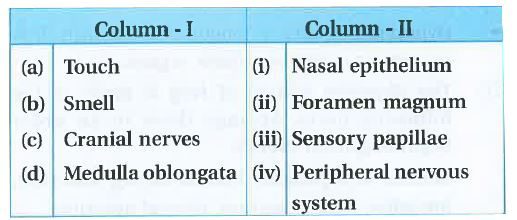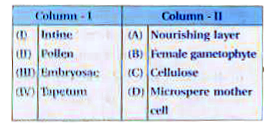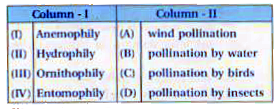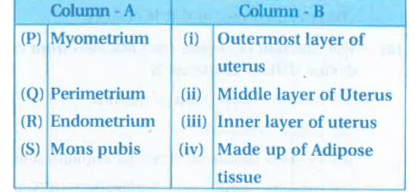கீழ்க்கண்டவற்றுள் "நைட்ரஜன்" பொறுத்தவரையில் சரியான கூற்றைக் கண்டறி. (I) மிக அதிக அளவில் தாவரங்களுக்கு தேவைப்படும். (II) இது நைட்ரேட் (NO) வடிவில் உள்ளெடுக்கப்படுகிறது. (III) இதன் குறைபாட்டால் பச்சையசோகை தோன்றும். (IV) இலைவிளிப்பு சுருள்தல் பற்றாக்குறை அறிகுறிகளில் ஒன்று
I மற்றும் III
I, II மற்றும் III
I, II, III, மற்றும் IV
I மற்றும் II
Topper's Solved these Questions
Similar Questions
கூற்று (A) : தைலக்காய்டுகளின் உள் இடைவெளியில் அதிகரிக்கும் பு£ராட்டான் செறிவானது ATP உற்பத்திக்கு காரணமாக உள்ளது. காரணங்கள் (B) : PSI-இல் காணப்படும் ஆக்ஸிஜன் வெளி6யற்றம் கூட்டமைப்பு தைலகாய்டு உறையின் மீது ஸ்ட்ரோமாவை நோக்கி காணப்படுவதுடன் H+அயனிகளை வெளியேற்றுகிறது.
View Solutionசிறுநீர் அடர்வு நெஃப்ரானின் எப்பகுதியைச் சார்ந்துள்ளது?
View SolutionFind : (i) 932 (ii) 3225 (iii) 1634 (iv) 125−13
View Solutioni. ii. iii. iv. iv. v.
View SolutionPredict the order of reactivity of following compounds in dehydrohalogenation. a. I. II. III. IV. V. b. I. II. III. IV.
View SolutionMatch the column-
Column IColumn IIA Toxinsi. MorphineB Alkaloidsii. AbrinC Lectinsiii. VinblastinD. Drugsiv. Concanavalin A
ABCDiiiiiiiviiiiiiiviiiiviiiviiiiii
View SolutionSelect the combination that correctly marches the fungi to respective class. {:(,(1),(2),(3),(4)),((I),i,iii,iv,ii),((II),ii,iii,iv,i),((III),iii,ii,i,iv),((IV),iv,i,ii,iii):}
View Solutionபின்வரும் வகையீடுகளைப் பொருத்துக
 . சரியான பொருத்தமானது
. சரியான பொருத்தமானது
View SolutionMatch the following with reference to cockroach and choose the correct option. (A) (a - iii), (b - iv), (c - ii), (d - i) (B) (a - iv), (b - iii), (c - ii), (d - i) (C) (a - iv), (b - ii), (c - iii), (d - i) (D) (a - ii), (b - iv), (c - iii), (d - i)
View SolutionMatch the followings and choose the correct answer.

(A) (a - iii), (b - i), (c - ii), (d - iv)
(B) (a - ii), (b - i), (c - iv), (d - iii)
(C) (a - iii), (b - iv), (c - ii), (d - i)
(D) (a - iii), (b - i), (c - iv), (d - ii)
View SolutionMatch the two columns: (A) (I-A),(II- B), (III- D), (IV- C) (B) (I-B), (II-A), (III-D), (IV - C) (C) (I- A), (II-B), (III-C), (IV- D) (D) (I- D), (II- A), (III-C), (IV-B)
View SolutionMatch the two columns:

(A) (I-C), (II-D), (III-B), (IV-A)
(B) (I-D), (II-C), (III-A), (IV-B)
(C) (I-C), (II-B),(III-D), (IV-A)
(D) (I-B),(II-D),(III-C),(IV-A)
View SolutionMatch the two columns:

(A) (I-A), (II-B), (III-C), (IV-D)
(B) (I-B), (II-A), (III-C), (IV-D)
(C) (I-A), (II-C), (III-B), (IV-D)
(D) (I-D), (II-B), (III-C), (IV-A)
View SolutionMatch Column A with Column B

(A) (P-i), (Q-ii), (R-iv), (S-iii)
(B) (P-ii), (Q-i), (R-iii), (S-iv)
(C) (P-ii), (Q-iii), (R-iv), (S-i)
(D) (P-iv), (Q-iii), (R-ii), (S-i)
View SolutionMatch the following (A) (i-P), (ii-S), (iii-R), (iv-Q) (B) (i-Q), (ii-S), (iii-P), (iv-R) (C) (i-Q), (ii-P), (iii-R), (iv-S) (D) (i-P), (ii-R), (iii-Q), (iv-S)
View SolutionPredict the order of reactivity of following compounds in dehydrohalogenation. a. I. II. III. IV. V. b. I. II. III. IV.
View Solution
